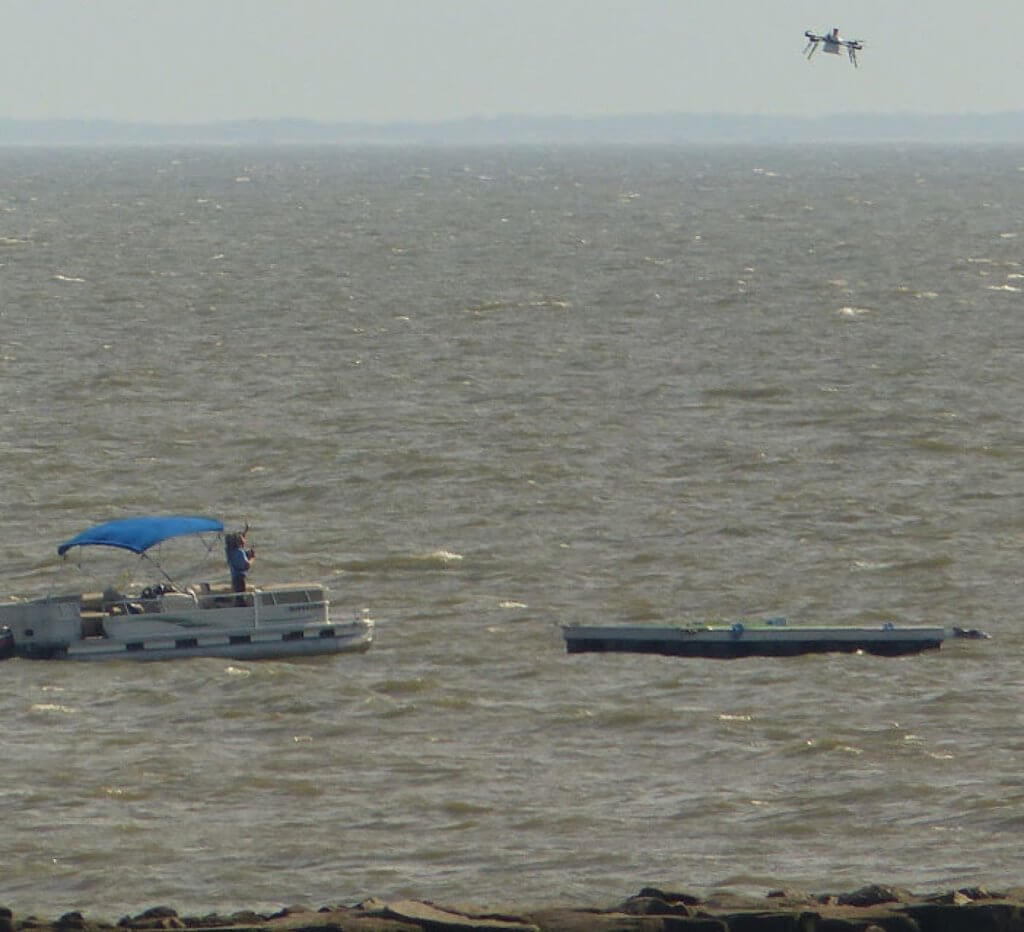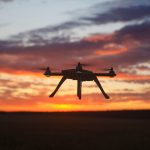NORTH CAPE MAY – A drone experiment made history June 22 when an unmanned aerial system flew medical test samples from the Delaware River and Bay Authority terminal to an offshore barge by Higbee Beach and back.
It was a test flight similar to the Wright Brothers’ first flight that paved the way for manned flight. The test was moved up a day due to foul weather predicted for June 23.
For personnel from the United Nations, who witnessed the flight along with observers from the Federal Aviation Administration, the test could open the skies for helping trapped victims of natural disasters get medical attention and supplies.
As ferries plied the 17-mile distance between here and Lewes, Del., in a stiff wind and choppy sea conditions, the crowd of aviation officials and UAS manufacturers watched the feat.
The premier ship-to-shore drone flight in the nation was performed by a drone produced by Flirtey. The drone was laden with samples of feces, blood, and urine. According to Dr. Timothy Amukele, assistant professor of pathology at Johns Hopkins University School of Medicine, such samples would be important for testing to aid stranded disaster victims in places too difficult for a vehicle to maneuver.
The joint mission proved the theory that an unmanned aircraft could convey life-saving aid to victims, such as in a hurricane like Katrina.
Another test flight of a Rutgers University drone showed how it could fly, then go underwater.
Flirtey Founder and CEO Matthew Sweeny provided narration for the flight. After Amukele had explained the samples, he handed the packaged goods to a Flirtey employee who packed them into the drone.
A few seconds later, the white quad-copter lifted off the grass higher with each passing second. Its target was within sight south of the Cape May Canal jetty where the ferry Delaware had headed south only minutes earlier.
As the drone became a mere speck in the sky, Sweeney kept a keen eye on the payload as the target barge bounced up and down in the choppy bay water. Guided by GPS, the drone dutifully lowered its white box of medical samples on the barge. After it had been retrieved by a crewmember, the drone lowered itself onto the barge.
After a few minutes, another white box was placed in the drone’s interior, and it took to the air again, heading back to the grassy landing area where the crowd watched, and Amukele waited.
Once on the ground, the smiling doctor was given his prized box.
History had been made.
The multi-day event was hosted by Cape May County, Delaware River and Bay Authority and the Field Innovation Team (FIT) had the theme Drones in Disaster “Do Tank.”
The demonstrations were targeted to show how robotics can be used to expedite humanitarian response and recovery operations.
In addition to UN agency representatives, others from the American Red Cross and the county Office of Emergency Management watched.
Freeholder Will Morey, who has overseen the county’s thrust of getting drones to test at the county airport, also observed the drone experiment.
In a release, Andrew Billo, humanitarian affairs officer with the UNOCHA, stated, “We recognize the opportunity for us to engage with drone developers and operators in ensuring the principled application of game-changing technologies in response to humanitarian crises around the world. Participating in this event supports the mission of the UN Office for the Coordination of Humanitarian Affairs to mobilize and coordinate effective humanitarian action with a broad range of partners.”
“Exploring new technologies and innovations, like drones, is one way that the American Red Cross can effectively prepare and respond to disasters around the world,” stated Matthew Gibb, Red Cross GIS expert. “The Drone Do Tank will allow us to collaborate with other humanitarian partners and understand the potential for emerging technologies,” he stated.
Scott Green, DRBA executive director, told the Herald that earlier in the day, a drone firm had provided high-resolution to the authority of the Cape May County Airport, where a storm June 21, caused damage to some structures and aircraft. Green said the firm also provided Atlantic City Electric with aerial photographs of damaged areas elsewhere in the storm-stricken area of Middle and Lower townships.
Crews from the utility were busy restoring power that had been disrupted by the storm when trees fell onto wires.
Wildwood Crest – Several of Donald Trump’s Cabinet picks have created quite a bit of controversy over the last few weeks. But surprisingly, his pick to become the next director of the FBI hasn’t experienced as much…








